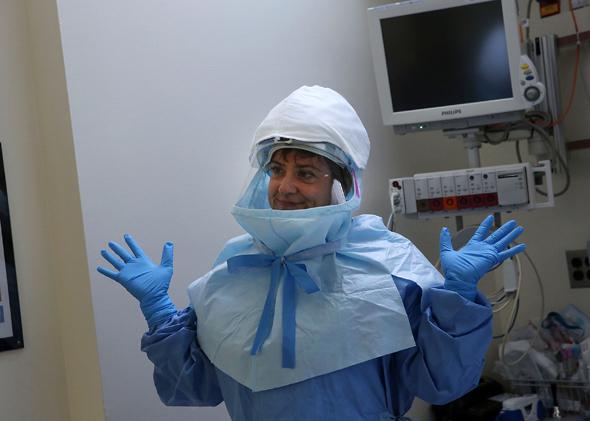On Oct. 12, the Centers for Disease Control and Prevention confirmed the first case of Ebola transmission in the United States. A nurse at Texas Health Presbyterian Hospital in Dallas who cared for Thomas Duncan, previously the only patient in the country diagnosed with the disease, tested positive for the virus. She is being treated in an isolation unit. How can health care workers avoid becoming infected with deadly diseases?
Health workers treating an Ebola patient wear gloves, a fluid-resistant gown, eye protection, and a face mask, per guidelines from the CDC. When dealing with bodily fluids, an extra layer of gloves and leg and shoe coverings are worn, too. These barriers prevent contact with the virus, but avoiding infection depends on donning them properly and removing them without touching their contaminated surfaces. It is “not easy to do right,” CDC Director Tom Frieden said in a press conference on Sunday. An accidental breach in the protocol for using this protective equipment is thought to be responsible for transmission from patient to nurse.
It is hard to track just what goes wrong if a misstep occurs, says Maureen O’Leary, secretary of the American Biological Safety Association. A case of Ebola reported in Spain last week involved a nurse trainee who admitted that she broke protocol by touching her face with a gloved hand after handling patient waste. Removing protective items that were used during care is complicated by the specificity of the process by which it must be done: “Using a gloved hand, grasp the palm area of the other gloved hand and peel off first glove; Hold removed glove in gloved hand; Slide fingers of ungloved hand under remaining glove at wrist and peel off second glove over first glove,” the CDC’s glove-removal instructions read. The meticulousness is necessary to distinguish between the contaminated parts of a gown or facemask and the parts that are safe to touch. Contamination often can’t be seen, so even the smallest deviation might create a problem, says Ken Anderson of the American Hospital Association. For this reason, “the sequence of removal is key” to prevent clean surfaces from touching dirty ones. The CDC recommends two possible protocols. Both end with washing hands thoroughly (for the duration of two rounds of “Happy Birthday to You,” according to Anderson).
Guidelines for safe protective equipment removal have been improved after previous disasters. Before the SARS epidemic of 2003, health workers were not well attuned to the risk posed by improperly taking off used gowns, gloves, and the like. But after a hospital in Canada saw dramatic declines in hospital-acquired SARS infections during the outbreak after instituting removal precautions, the CDC was spurred to recommend better measures for teaching health care workers about proper disposal. Since 2009, there has been a notable decrease in hospital-acquired infections of all kinds, in part due to these better protocols.
But knowledge gaps, human error, and nervousness make perfect compliance elusive. On Sunday, following the CDC’s remarks suggesting the nurse in Texas who has contracted Ebola must have done so following a protocol mistake, National Nurses United, the country’s largest nurses union, protested that hospitals are not doing enough to prepare workers for dealing with Ebola. Writing in the Washington Post, RoseAnn DeMoro, the NNU’s head, blames our fragmented health care system and calls for more federal leadership. Though training on how to don and doff medical protective kits is routine, the NNU says its members are uncertain and want more direction to feel better equipped at handling the disease. The CDC says it will increase hands-on lessons and outreach at hospitals. Success will depend on everyone involved, not just nurses sticking to protocol under pressure: Studies consistently find that the biggest challenge isn’t the complexity of how to put on or take off the suit and gloves but having the right equipment, enough time, and a culture of safety that emphasizes the importance of doing things right.
